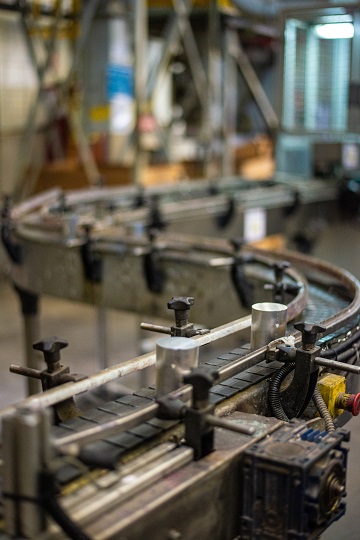In the fast-paced world of manufacturing, the condition of equipment plays a vital role in ensuring product availability for customers. However, it’s not uncommon for manufacturing machines to encounter problems, leading to rescheduled production and disruptions in the supply chain.
In this blog post, we will explore strategies to address equipment issues, ways to avoid them altogether, and the impact of these challenges on the overall supply chain. Additionally, we’ll discuss the key players responsible for resolving such issues.
But before we delve deeper, make sure you have joined the scmguide telegram channel to receive notifications of the latest posts from this blog as well as more insights on supply chain management.
Table of Contents
The Challenge of Equipment Problems and Rescheduled Production
Manufacturing equipment malfunctions or breakdowns can pose significant challenges for companies.
When equipment fails, it directly affects production schedules, leading to delays in delivering products to customers. These delays can have severe consequences for businesses, including dissatisfied customers and potential loss of future business opportunities.
The Production Planning, Inventory Control (PPIC) department plays a crucial role in managing production schedules and inventory.
When equipment problems occur, the PPIC team is tasked with rescheduling production to accommodate the downtime and ensure that customer orders are fulfilled. However, rescheduling production comes with its own set of complications.
Firstly, rescheduled production disrupts the carefully planned production schedule, which can cause delays and impact the overall efficiency of operations. It requires the coordination of various departments, such as production, procurement, and logistics, to adjust their plans accordingly.
Secondly, managing inventory becomes more challenging. When production is delayed due to equipment problems, there may be a mismatch between the available inventory and customer demands. This can lead to stockouts of certain products, leaving customers unsatisfied and potentially seeking alternative suppliers.

Thirdly, rescheduling production can have a cascading effect on the entire supply chain. It can impact the procurement of raw materials, as the revised production schedule may require adjustments in the quantity and timing of material orders. Suppliers may face challenges in meeting the revised demands, further exacerbating delays.
Moreover, rescheduled production can strain relationships with customers who rely on timely delivery of products. Late deliveries may lead to dissatisfied customers, damaged reputation, and potential loss of future business. Meeting customer demands and expectations becomes more difficult when equipment problems disrupt the production schedule.
Equipment problems and subsequent rescheduled production present significant challenges for manufacturers. Delays in production schedules can result in dissatisfied customers, missed business opportunities, and strain on the overall supply chain.
The PPIC department plays a critical role in managing these challenges, but it requires coordination and adjustments across departments to minimize the impact on inventory management and meet customer demands effectively.
Avoiding Equipment Problems
To minimize equipment-related issues and prevent disruptions in production, manufacturers should implement effective strategies and practices.
Here are some key approaches to avoid equipment problems.
Regular Maintenance and Inspection Protocols
Regular maintenance is crucial for keeping manufacturing equipment in optimal condition.
Establishing a maintenance schedule and adhering to it ensures that equipment is routinely inspected, cleaned, and serviced. This helps identify and address potential issues before they escalate into major problems.
Preventive and Predictive Maintenance Strategies
In addition to regular maintenance, manufacturers should implement preventive and predictive maintenance strategies.
Preventive maintenance involves performing scheduled maintenance tasks, such as replacing worn-out parts or lubricating components, to prevent breakdowns.
Predictive maintenance utilizes data and analytics to monitor equipment performance, detect anomalies, and anticipate potential failures.
By taking proactive measures based on predictive insights, manufacturers can avoid equipment problems and minimize downtime.
Staff Training and Skill Development
Ensuring that employees are properly trained and skilled in operating and maintaining the machinery is essential.

Manufacturers should invest in comprehensive training programs to educate the workforce on equipment handling, troubleshooting, and maintenance procedures.
Well-trained staff can detect early warning signs, address minor issues promptly, and contribute to a culture of equipment care and reliability.
You might also like:
- Pallets in the Factory: Dedicated or General-Purpose?
- Prioritizing Your Efforts: Don’t Get Overwhelmed with Supply Chain Management
Embracing Technological Advancements
Leveraging technological advancements can significantly aid in avoiding equipment problems.
Condition monitoring systems, for example, continuously monitor equipment health in real-time, providing alerts for potential issues.
Automation technologies can streamline operations, reduce human error, and optimize equipment performance.
By embracing such advancements, manufacturers can enhance early problem detection, prevent breakdowns, and improve overall equipment reliability.
It is worth noting that equipment maintenance and avoidance strategies may vary depending on the specific machinery and industry. Manufacturers should tailor their approaches based on the unique requirements and characteristics of their equipment.
By prioritizing regular maintenance, implementing preventive and predictive maintenance strategies, providing proper training to staff, and embracing technological advancements, manufacturers can reduce the likelihood of equipment problems.
These proactive measures not only help avoid disruptions in production but also contribute to improved efficiency, increased productivity, and enhanced overall operational performance.
Mitigating the Impact on the Supply Chain
Equipment problems can have a ripple effect on the entire supply chain.
Raw material procurement may be delayed, leading to shortages and production bottlenecks.
Inventory management becomes more challenging, as disruptions in production can result in stockouts or excess inventory.
Logistics and timely delivery are compromised, affecting customer satisfaction and retention.
Thus, it is crucial to address equipment issues promptly to minimize their impact on the supply chain.
Collaborative Efforts to Address Equipment Issues
Resolving equipment problems is a collective effort that involves collaboration among different departments within an organization.
Here’s a more detailed explanation of the collaborative efforts needed to address equipment issues effectively.
Cross-Functional Collaboration
Resolving equipment problems requires collaboration between departments such as production, maintenance, and quality control.
Each department brings valuable expertise and perspectives to the table.

By working together, they can combine their knowledge and skills to diagnose and resolve equipment issues more effectively.
Cross-functional collaboration ensures that everyone is aligned and working towards a common goal of equipment reliability and optimal production performance.
Identification and Communication
Establishing effective communication channels is vital for addressing equipment issues promptly.
When an equipment problem arises, it should be communicated to the relevant departments in a timely manner.
This ensures that all stakeholders are aware of the issue and can contribute to its resolution.
Open lines of communication enable quick and efficient problem identification, allowing for a prompt response to minimize disruptions.
Swift Problem Resolution
Once an equipment problem is identified, cross-functional collaboration enables teams to work together to find solutions.
By pooling their expertise and resources, departments can brainstorm and implement effective problem-solving strategies.
This may involve conducting root cause analysis, sharing knowledge and insights, and exploring different approaches to address the issue.
Collaborative problem resolution helps expedite the restoration of equipment functionality and minimizes production downtime.
Continuous Improvement Processes
Collaboration should extend beyond the immediate resolution of equipment problems. Establishing continuous improvement processes ensures that lessons learned from each issue are captured and applied to prevent future occurrences.
This involves conducting post-mortem analyses, documenting best practices, and implementing corrective actions to enhance equipment reliability.
By continuously learning from past experiences and refining processes, organizations can improve overall equipment performance and prevent recurring issues.
Effective cross-functional collaboration is facilitated by a culture of teamwork, mutual respect, and shared accountability.
Organizations should promote a collaborative mindset among employees, encouraging them to actively engage in problem-solving efforts and contribute their insights.

Regular team meetings, collaborative projects, and knowledge-sharing initiatives can further foster a culture of collaboration and continuous improvement.
By fostering cross-functional collaboration, establishing effective communication channels, and embracing continuous improvement processes, organizations can address equipment issues more efficiently.
This collaborative approach not only resolves immediate problems but also cultivates a culture of shared responsibility and continuous enhancement of equipment reliability, leading to improved operational performance and customer satisfaction.
You might also like:
- Mastering the Game of Supply Chain Management: Think Like a Chess Player
- ERP Claims: Improving Organizational Efficiency, but Beware of New Inefficiencies
Leveraging Data and Analytics
Data and analytics have become invaluable tools in managing equipment issues and optimizing manufacturing operations.
Here’s a more detailed explanation of how data and analytics can be leveraged to address equipment problems.
Real-time Monitoring Systems
Real-time monitoring systems collect and analyze data from equipment sensors, providing valuable insights into the health and performance of the machinery.
By continuously monitoring key parameters such as temperature, vibration, and energy consumption, manufacturers can detect anomalies and potential issues early on.
Real-time monitoring enables proactive maintenance by allowing maintenance teams to intervene before equipment failures occur.
This helps minimize downtime, reduce repair costs, and prevent production disruptions.
Predictive Analytics
Predictive analytics utilizes historical data and machine learning algorithms to forecast potential equipment failures.
By analyzing patterns and trends in the data, predictive analytics models can identify signs of impending failures and issue timely alerts.
Maintenance teams can then take preventive measures, such as scheduling maintenance activities or replacing parts proactively, to avoid equipment breakdowns.
Predictive analytics empowers manufacturers to move from reactive to proactive maintenance strategies, resulting in improved equipment reliability and reduced downtime.
Root Cause Analysis
When equipment problems occur, root cause analysis is essential for identifying the underlying reasons behind the issues.
Data and analytics help in conducting in-depth analyses to pinpoint the root causes accurately.
By analyzing historical data, performance metrics, and maintenance records, manufacturers can uncover patterns, correlations, and dependencies that contribute to equipment problems.

Understanding the root causes allows for more effective problem-solving strategies, addressing the fundamental issues rather than just the symptoms. This leads to long-lasting solutions and improved equipment performance.
Data-driven Decision Making and Performance Metrics
Data and analytics enable manufacturers to make informed decisions regarding equipment maintenance, optimization, and resource allocation.
By analyzing performance metrics and key performance indicators (KPIs), organizations can gain insights into equipment efficiency, utilization, and overall operational performance.
Data-driven decision making helps identify areas for improvement, optimize maintenance schedules, and allocate resources more effectively.
Performance metrics also provide a basis for benchmarking and setting targets, driving continuous improvement efforts.
It’s important for manufacturers to establish data collection mechanisms, integrate data from various sources, and invest in analytics tools and expertise to effectively leverage data for equipment management.
Additionally, collaboration between data analysts, maintenance teams, and other relevant departments is crucial to extract meaningful insights from the data and translate them into actionable strategies.
By leveraging data and analytics, manufacturers can proactively monitor equipment, predict failures, conduct root cause analysis, and make data-driven decisions to optimize equipment performance and drive operational efficiency. This ultimately leads to improved productivity, reduced downtime, and enhanced overall equipment reliability.
Enhancing Equipment Reliability
Enhancing equipment reliability is crucial for ensuring smooth production operations and minimizing disruptions.
Here’s a more detailed explanation of strategies to improve equipment reliability:
Upgrading to Modern Machinery
Upgrading to modern machinery with advanced features can significantly improve equipment reliability.
Newer equipment often incorporates technological advancements, such as improved materials, enhanced design, and better control systems.
These advancements contribute to increased performance, reduced maintenance requirements, and enhanced overall reliability.
By investing in modern equipment, manufacturers can minimize the risk of breakdowns and improve production efficiency.
Considering Redundancy and Backup Systems
To mitigate the impact of equipment failures, it is essential to consider redundancy and backup systems.
Redundancy involves having duplicate equipment or backup systems in place to ensure continuity of production when primary equipment fails.

This can involve having spare machines, backup power sources, or redundant production lines.
Redundancy measures minimize downtime and enable swift transition to alternative equipment, reducing the impact of equipment failures on overall production.
Building Strong Supplier Relationships and Quality Assurance
Building strong relationships with equipment suppliers is crucial for ensuring equipment reliability.
Collaborating closely with suppliers can help in selecting high-quality equipment that meets specific operational requirements.
Establishing rigorous quality assurance processes, including thorough inspections and testing, ensures that only reliable and well-functioning equipment is integrated into the manufacturing process.
Regular audits and supplier performance evaluations further contribute to maintaining high equipment reliability standards.
Embracing Industry Best Practices and Benchmarking
Embracing industry best practices and benchmarking against competitors provides valuable insights for enhancing equipment reliability.
Learning from the experiences of other manufacturers in the industry helps identify effective strategies and innovative approaches to equipment management.
Benchmarking allows manufacturers to compare their equipment reliability performance with industry leaders, identify gaps, and set improvement targets.
Continuous improvement efforts driven by best practices and benchmarking can lead to enhanced equipment reliability and performance.
Additionally, manufacturers should prioritize employee training and skill development to ensure proper operation and maintenance of equipment.
Well-trained operators and maintenance staff are more adept at detecting early warning signs of equipment issues, implementing preventive measures, and addressing minor problems before they escalate.
By upgrading to modern machinery, considering redundancy and backup systems, building strong supplier relationships, implementing quality assurance processes, and embracing industry best practices, manufacturers can enhance equipment reliability.
These strategies contribute to minimizing equipment failures, reducing downtime, optimizing production efficiency, and ultimately improving overall operational performance.
You might also like:
- Too Much Collaboration in Supply Chain Management? Understanding the Risks
- Getting the Right Balance: How to Choose Between MRP and Reorder Point for Raw Material Availability
The Bottom Line: Ensuring Sustainable Operations
Maintaining a balance between cost and equipment reliability is essential.
While cost-cutting measures may seem appealing in the short term, they can lead to compromised equipment condition and increased downtime in the long run.

Manufacturers must emphasize long-term investments in equipment maintenance and upgrades to ensure sustainable operations.
Building a culture of continuous improvement fosters a proactive approach towards addressing equipment issues.
Incorporating flexibility into production planning allows for adaptability in the face of unexpected equipment problems or changes in customer demands.
Conclusion
The condition of manufacturing equipment significantly impacts product availability for customers.
By proactively addressing equipment issues, implementing preventive measures, and fostering collaborative efforts, manufacturers can minimize disruptions, enhance supply chain performance, and meet customer expectations.
It is the collective responsibility of various stakeholders, including PPIC, production, maintenance, and quality control teams, to work together towards achieving sustainable operations and an optimized manufacturing process.
Through ongoing innovation, investment, and a commitment to excellence, manufacturers can mitigate the impact of equipment issues and ensure smooth operations for the benefit of all involved.
By prioritizing regular maintenance, implementing preventive strategies, and leveraging data and analytics, manufacturers can minimize the occurrence of equipment problems.
This proactive approach reduces the need for rescheduled production, resulting in improved customer satisfaction and a more efficient supply chain.
The impact of equipment problems on the overall supply chain is far-reaching.
Delays in production can disrupt the procurement of raw materials, leading to shortages and inventory management challenges.
Timely delivery of products may be compromised, affecting customer satisfaction and retention.
These disruptions can have long-term consequences on business relationships and profitability.
To address equipment issues effectively, collaboration is key.
Production, maintenance, and quality control teams must work in harmony, sharing information and coordinating efforts.
Effective communication channels and continuous improvement processes ensure that equipment problems are identified and resolved promptly.
Furthermore, manufacturers should embrace technological advancements to enhance equipment reliability.
Upgrading to modern machinery with advanced features can improve overall performance and reduce the risk of breakdowns.
Implementing redundancy and backup systems provides an added layer of protection against equipment failures.
Suppliers also play a crucial role in maintaining equipment condition.
Building strong relationships with suppliers and implementing stringent quality assurance processes ensure that only reliable and high-quality equipment is used in the manufacturing process.
In conclusion, the condition of manufacturing equipment is paramount in ensuring product availability for customers.
By adopting a proactive approach to address equipment problems, implementing preventive measures, and fostering collaboration among key stakeholders, manufacturers can minimize disruptions in the supply chain and deliver products on time.
The collective efforts of the PPIC, production, maintenance, and quality control teams are essential in resolving equipment issues and ensuring sustainable operations.
By investing in maintenance, embracing technological advancements, and building strong supplier relationships, manufacturers can achieve optimal equipment reliability and drive overall business success.
Hope it is useful!
Please also share this article with your colleagues so that they can benefit from it as well. Join our scmguide telegram channel to receive notifications of the latest posts from this blog and gain more insights into supply chain management. All articles on this blog are free for you to use for any purpose, including commercial, without the need for attribution.
 by
by 

